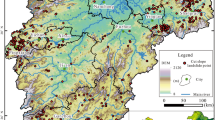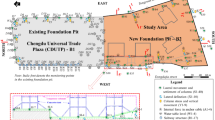Abstract
Considering growing population and decreasing mineral resource reserves, the issue of undermining has been and shall remain very topical. This study aims to identify the mutual connections between mined out panels of a deposit and the final manifestations on the ground surface related to deep black coal mining. On the grounds of the identified connections, the study describes a method to simplify a common evaluation of undermined areas according to building site categories. Within the study, a demarcation of the areas was conducted in two localities in Czech Republic influenced by the effects of undermining in the Upper-Silesian Basin. In the allotment of the CSM Mine, an area unsuitable for founding structures was defined from the centre of the worked out workings to the distance of 175 m from the panel's edge, for which the corresponding break angle is 78.3°. Similarly, in the allotment of the Paskov Mine, an area unsuitable for founding structures was determined to the distance of 500 m from the panel's edge, for which the corresponding break angle is 50.2°. This demarcation may be implemented prior to deposit mining being aware of several physical-mechanical parameters of rocks in the deposit's overburden. Having mined out a particular section of a deposit, it is recommended to verify the values of break angle using the method described herein. The study may be applied as a relatively fast and effective method to evaluate future land use for planning.








Similar content being viewed by others
References
Aksoy, C. O., Kose, H., Onargan, T., Koca, Y., & Heasley, K. (2004). Estimation of limit angle using laminated displacement diskontinuity analysis in the Soma coal field, Western Turkey. International Journal of Rock Mechanics & Mining Sciences, 41, 547–556.
Bednarik, M., Magulova, B., Matys, M., & Marschalko, M. (2010). Landslide susceptibility assessment of the Kraovany–Liptovski Mikulas railway case study. Physics and Chemistry of the Earth, Parts A/B/C, 35(3–5), 162–171.
Chen, J. J., Zou, Y. F., & Guo, W. B. (2007). Research on parameters of protective coal pillar of buildings in deep-lying mining. Progress in Mining Science and Safety Technology, 212, 209–212.
Chlupáč, I., Brzobohatý, R., Kovanda, J., & Stráník, Z. (2000). Geologická minulost České republiky [Geological history of the Czech Republic]. Akademie věd ČR. pp. 167–172. (in Czech).
Cui, X., Wang, J., & Liu, Y. (2001). Prediction of progressive surface subsidence above longwall coal mining using a time function. International Journal of Rock Mechanics & Mining Sciences, 38, 1057–1063.
Čurda, J., Drábková, E., Eliáš, M., Jinochová, J., Kašpárek, M., Manová, M., et al. (1998). Notes to the set of geological and ecological special-purpose maps of natural resources in 1:50 000 scale (Sheet 15–44 Karviná) (p. 89). Prague: Czech Geological Institute.
Forte, F., Strobl, R. O., & Pennetta, L. (2006). A methodology using GIS, aerial photos and remote sensing for loss estimation and flood vulnerability analysis in the Supersano-Ruffano-Nociglia Graben, southern Italy. Environmental Geology, 50, 581–594.
Galve, J. P., Bonachea, J., Remondo, J., Gutiérrez, F., Guerrero, J., Lucha, P., et al. (2008). Development and validation of sinkhole susceptibility models in mantled karst settings. A case study from the Ebro valley evaporite karst (NE Spain). Engineering Geology, 99, 185–197.
Holla, L. (1997). Ground movement due to longwall mining in high relief areas in New South Wales, Australia. International Journal of Rock Mechanics and Mining Sciences, 34, 775–781.
Kachlík, V. (2003). Geologický vývoj území České republiky [Geological evolution of the Czech Republic]. Ústav geologie a paleontologie, Přírodovědecká fakulta UK, Praha, pp. 36–40. (in Czech).
Kaufmann, O., & Quinif, Y. (2002). Geohazard map of cover-collapse sinkholes in the ‘Tournaisis’ area southern Belgium. Engineering Geology, 65, 117–124.
Li, W. X., Wen, L., & Liu, X. M. (2010). Ground movements caused by deep underground mining in Guan-Zhuang iron mine, Luzhong, China. International Journal of Applied Earth Observation and Geoinformation, 12, 175–182.
Liu, J., & Elsworth, D. (1994). Evaluation of pore water pressure fluctuation around an advancing longwall face. Advance in Water Resources, 22, 633–644.
Marschalko, M., Yilmaz, I., Bednárik, M., & Kubečka, K. (2011). Variations in the building site categories in the underground mining region of Doubrava (Czech Republic) for land use planning. Engineering Geology, 122(3–4), 169–178.
Marschalko, M., Bednárik, M., Yilmaz, I., Bouchal, T., & Kubečka, K. (2012). Evaluation of subsidence due to underground coal mining: An example from the Czech Republic. Bulletin of Engineering Geology and the Environments, 71(1), 105–111.
Mattson, L. L., & Magers, J. A. (1998). Ground-water variation at a western longwall coal mine. Land subsidence case studies and current research: Proceedings of the Dr Joseph F. Poland Symposium on Land Subsidence, pp. 275–280.
Mills, R., Archibeque, S., Dowling, G., & Breeds, C. D. (1999). Subsidence experience at Twentymile Coal Company. Rock Mechanics for Industry, pp. 455–463.
Neset, K. (1984). Vlivy poddolování [Effects of mining subsidence]. SNTL, Praha, pp. 344. (in Czech).
Oh, H., & Lee, S. (2010). Assessment of ground subsidence using GIS and the weights-of-evidence model. Engineering Geology, 115, 36–48.
Safari, H. O., Pirasteh, S., Pradhan, B., & Gharibhvand, L. K. (2010). Use of remote sensing data and GIS tools for seismic hazard assessment of shallow oilfields and its impact on the settlements in and around Masjed-i-Soleiman area, Zagros Mountains, Iran. Remote Sensing, 2(5), 1364–1377.
Safari, H. O., Pirasteh, S., Pradhan, B., & Amid, H. (2011). Geohazards analysis of Pisa tunnel in a fractured incompetent rocks in Zagros Mountains, Iran. Arabian Journal of Geosciences. doi:10.1007/s12517-011-0427-z.
Sheorey, P. R., Loui, J. P., Singh, K. B., & Singh, S. K. (2000). Ground subsidence observations and a modified influence function method for complete subsidence prediction. International Journal of Rock Mechanics and Mining Sciences, 37, 801–818.
Singh, K. B., & Singh, T. N. (1998). Ground movements over longwall workings in the Kamptee coalfield, India. Engineering Geology, 50, 125–139.
Wang, X., & Qin, Y. (2006). Spatial distribution of metals in urban topsoils of Xuzhou (China): Controlling factors and environmental implications. Environmental Geology, 49(6), 905–914.
Whittaker, B. N., & Pasamehmetoglu, A. G. (1981). Ground tilt in relation to subsidence in longwall mining. International Journal of Rock Mechanics and Mining Sciences & Geomechanics, 18, 321–332.
Yavuz, H. (2004). An estimation method for cover pressure re-establishment distance and pressure distribution in the goaf of longwall coal mines. International Journal of Rock Mechanics & Mining Sciences, 41, 193–205.
Yilmaz, I. (2007). GIS based susceptibility mapping of karst depression in gypsum: A case study from Sivas basin (Turkey). Engineering Geology, 90(1–2), 89–103.
Yilmaz, I. (2008). A case study for mapping of spatial distribution of free surface heave in alluvial soils (Yalova, Turkey) by using GIS software. Computers and Geosciences, 34(8), 993–1004.
Yilmaz, I. (2009). Landslide susceptibility mapping using frequency ratio, logistic regression, artificial neural networks and their comparison: A case study from Kat landslides (Tokat-Turkey). Computers and Geosciences, 35(6), 1125–1138.
Yilmaz, I. (2010). Comparison of landslide susceptibility mapping methodologies for Koyulhisar, Turkey: Conditional probability, logistic regression, artificial neural networks, and support vector machine. Environental Earth Sciences, 61(4), 821–836.
Yilmaz, I., & Bagcı, A. (2006). Soil liquefaction susceptibility and hazard mapping in the residential area of Ku¨tahya (Turkey). Environmental Geology, 49(5), 708–719.
Yilmaz, I., & Yavuzer, D. (2005). Liquefaction potentials and susceptibility mapping in the city of Yalova, Turkey. Environmental Geology, 47(2), 175–184.
Youssef, A. M., Pradhan, B., Sabtan, A. A., & Harbi, H. M. E. (2012). Coupling of remote sensing data aided with field investigations for geological hazards assessment in Jazan area, Kingdom of Saudi Arabia. Environmental Earth Sciences, 65, 119–130.
Acknowledgements
The authors thank the European Union (CENTRAL EUROPE Programme co-financed by the ERDF) for the support of the project (COBRAMAN–1CE014P4), which is the base of this article. The authors also thank the anonymous reviewers for very constructive suggestions and criticisms, which led to the improvement of the article.
Author information
Authors and Affiliations
Corresponding author
Rights and permissions
About this article
Cite this article
Marschalko, M., Yilmaz, I., Křístková, V. et al. An indicative method for determination of the most hazardous changes in slopes of the subsidence basins in underground coal mining area in Ostrava (Czech Republic). Environ Monit Assess 185, 509–522 (2013). https://doi.org/10.1007/s10661-012-2571-7
Received:
Accepted:
Published:
Issue Date:
DOI: https://doi.org/10.1007/s10661-012-2571-7




